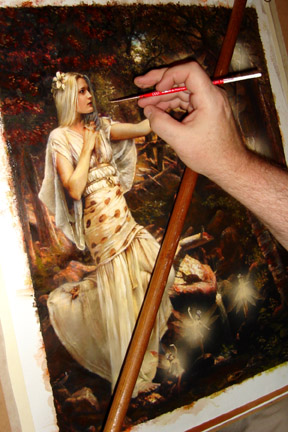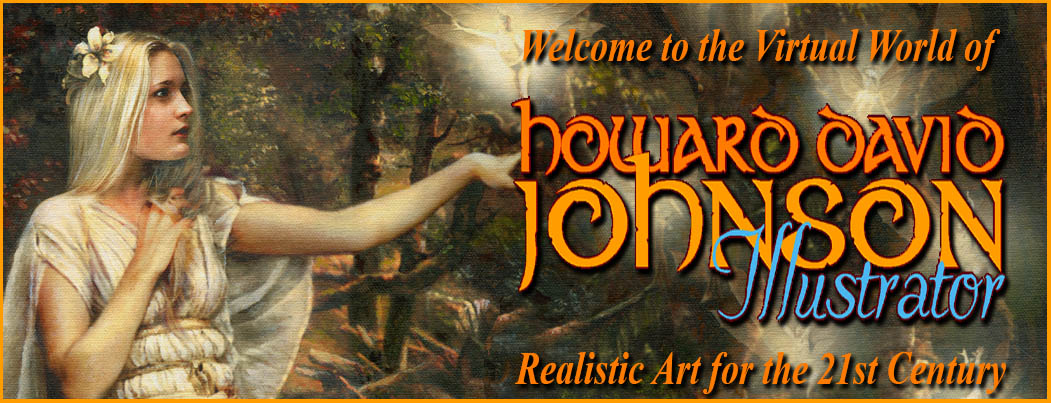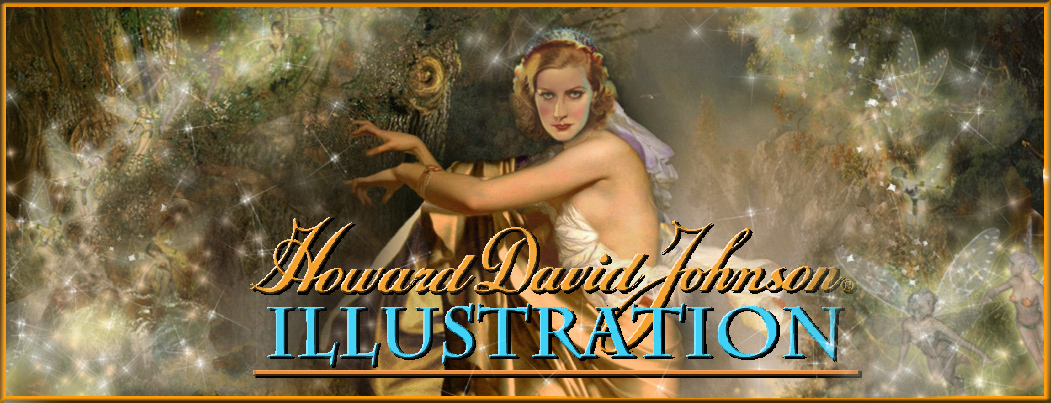
The Fairy Paintings Educational Art Gallery... Featuring Realistic Fairy Paintings and Pictures of Celtic, Shakespearean, and Victorian Fairies - Fairy Art created in a style inspired by Classic Illustrators by Contemporary American Artist and Photographer Howard David Johnson, whose illustrations of Folklore and Mythology have been published all over the world by distinguished learning institutions and publishers including the Universities of Oxford and Cambridge... Seen all the great old Fairy pictures in famous books and on calendars and cards and STILL can't get enough? This exhibit is for you! Newly updated for 2025!
|
|

Welcome lovers of Fairy Paintings and Faerie Art -
This Celtic, Shakespearean, and Victorian Fairy Paintings art gallery welcomes you to this celebration of all things Faerie...



"Lurline, the Ethereal Queen of the Fairies", Fairy Queen NYX, Bringer of Sleep and Death" and "The Seelie Wight" [MMXXIV]
Fairies: also Faerie or Faery, the common term for a legendary race of clever super- natural beings who meddle in human affairs. Commonly associated with the Celts, Fairies are not the product of one culture or time; they have a pedigree. Ancient Greek Heroes had fairy lemans, called nymphs, and the faraway Asians, Eskimos and American Indians had similar fairy legends as well. The mythic Gandharvas of Sanskrit poetry were also fairies. In "Fairy Land" this love of folklore lives on today. Notice how the fairies turn into butterflies and birds when they go out into the direct sunlight...
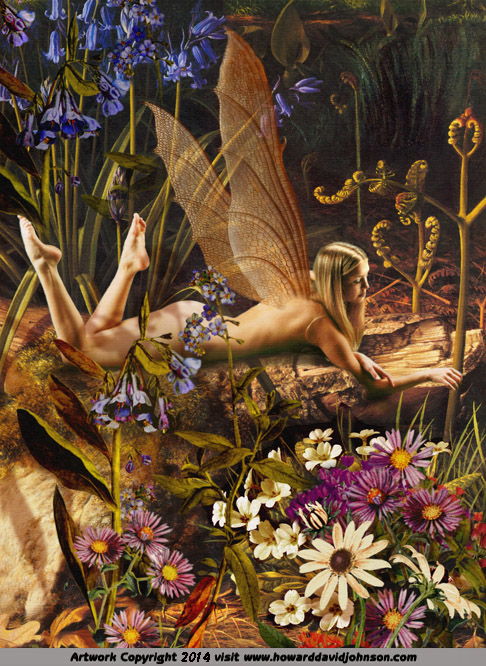
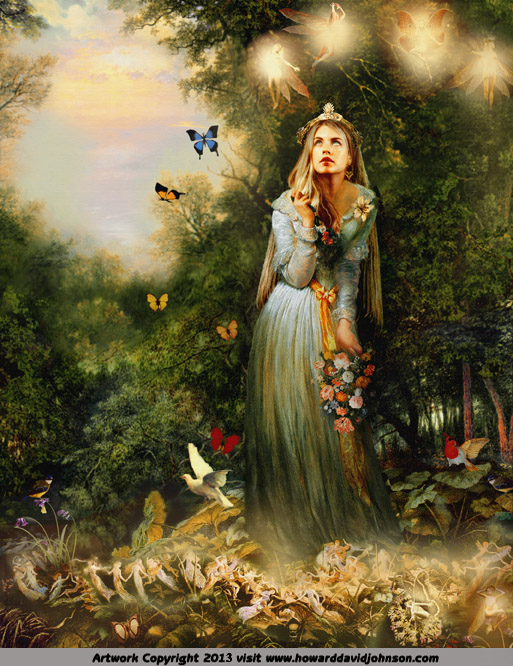

"The Flower Fairy" "Fairy Land,"and "Fae Lament" [MMII-MMXIV all in mixed media]
THE FAERIE QUEENS
The blazing brightnesse of her beauties beame, And glorious light of her sunshyny face To tell, were as to striue against the streame. My ragged rimes are all too rude and bace, Her heauenly lineaments for to enchace. Ne wonder; for her owne deare loued knight, All were she dayly with himselfe in place, Did wonder much at her celestiall sight: Oft had he seene her faire, but neuer so faire dight.So she beheld those maydens meriment With chearefull vew; who when to her they came, Themselues to ground with gratious humblesse bent, And her ador'd by honorable name, Lifting to heauen her euerlasting fame: Did seeme such, as she was, a goodly maiden Queene. ~
"Ye Faerie Queene" by Edmund Spenser [1596]

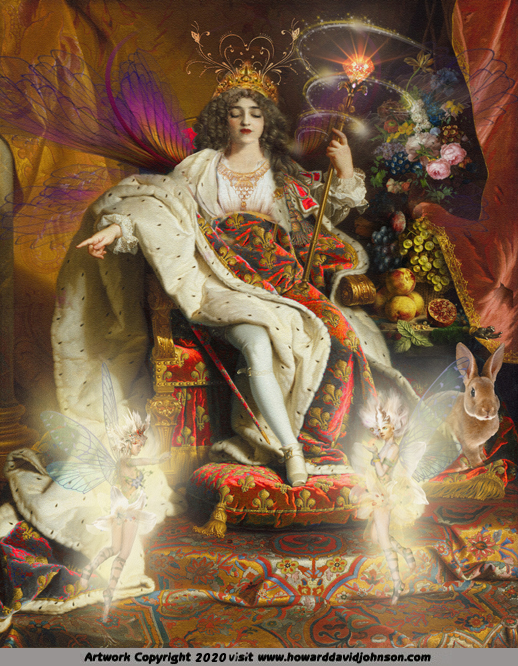
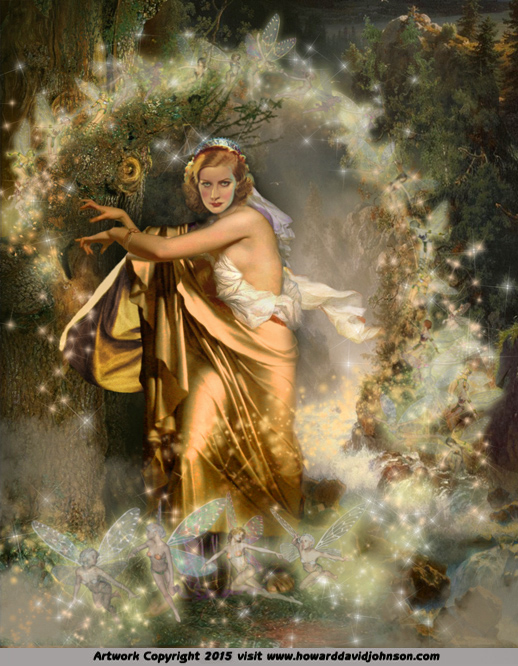
"Ye Faerie Queene", "Oona - last High Queen of the Daoine Sidhe" and "Morgan Le Fay" or Morgan of the Fairies
THE FAERIE KINGS
Echoes of pre-historic myth bring forth visions of heroes of romance and fairy kings, monarchs of great splendor, riches and generosity who enjoyed the admiration of all. We are also told that all fairy haunted places, wherever they may be- belong to them.
( Brun de la Montage, Biblitheque Nationale )
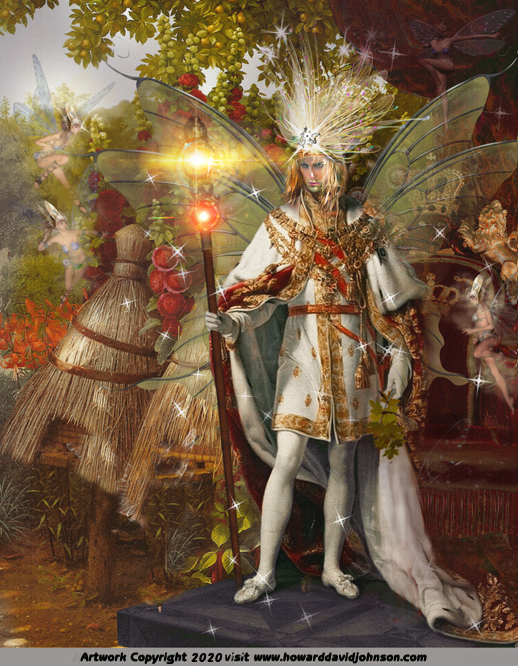
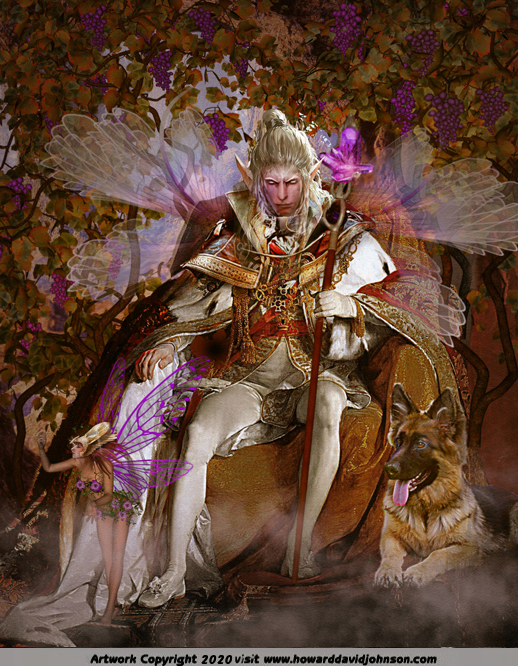
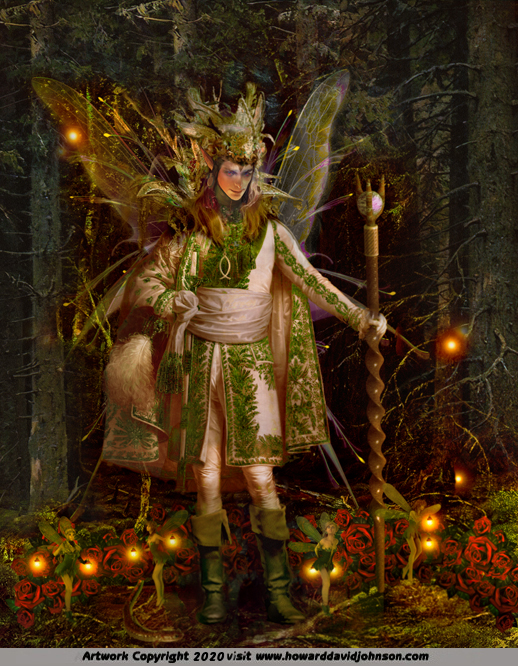
The Brothers Fae; "King Edern of the House of Llŷr", "Gwyn ap Nudd, the King of Elfland", and " Fionnbharr, High King of the Daoine Sidhe "
FAERIE KNIGHTS and PRINCES
The nearest analogy to the shape of fairy belief in Scotland and Ireland - the Pixies of southern England is that of the popular oral traditions of the early Arabs. Since ancient times, the Irish have referred to fairies as the Shee, ( or Sidhee in Gaelic. ) Other names for fairy and fairy like creatures include the fay, sprite, elf, brownie, pixie, pixy, Robin Goodfellow, dwarf, gnome, troll, kobold, peri, hobgoblin, leprechaun, and also included are the nymph, dryad, oceanid, hamadryad, naiad, neried, oread, undine, faun, satyr & mermaid.
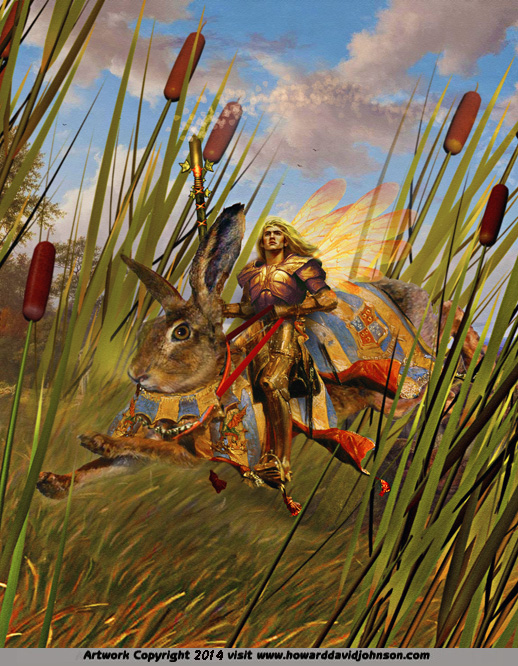
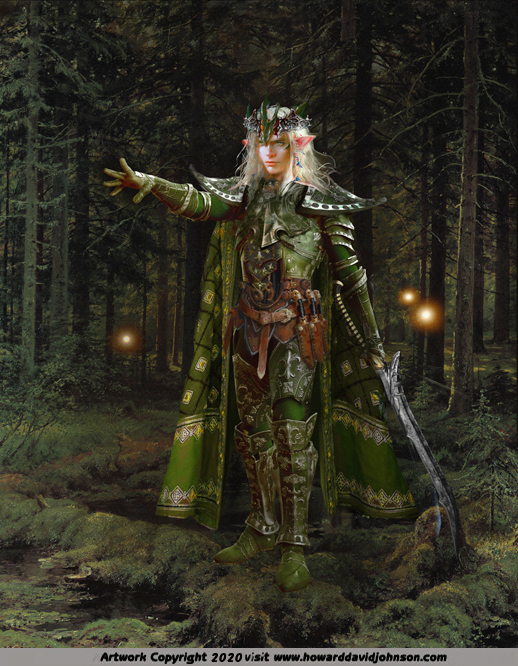

"The Faerie Knight, grandson of King Arthur" , The Wand-Elf Knight" center and "The Dandelion Fairy"
FAIRY FOLKLORE
"Fairy Paintings": During the Romantic era renewed interest was aroused in fairy tales, folk stories and legends all over Europe. The best books on Celtic Fairy lore are still "The Secret Commonwealth of Elves, Fauns, and Fairies" by the Rev. Mr. Kirk and Keightley's "Fairy Mythology", but they are difficult to obtain. Fortunately "Fairies" by Contemporary Fairy painting masters Brian Froud and Alan Lee is back in print and an absolutely delightful edition for any collector or enthusiast. The belief in a species of Lady Fairies, deathly to their human lovers was as common in Samoa as on the banks of Loch Awe. Many fairy tales popular today like "Sleeping Beauty" and "Snow white" had their origins in the folk tales of prehistoric times. The Fairy women who come to the births of children and foretell their fortunes with their spindles legends were found in ancient Egypt. A female spirit who wailed to foretell death was called a Banshee. The Greek Sirens of Homer are a form of these Fairies, as the Nereids, Oreads, and Naiads are fairies of wells, mountains, and the sea.
SCARY FAIRIES and GOBLINS
"In reality there were only bloody faery tales. The origins of every faery tale are steeped in blood and fear..."
~ Franz Kafka
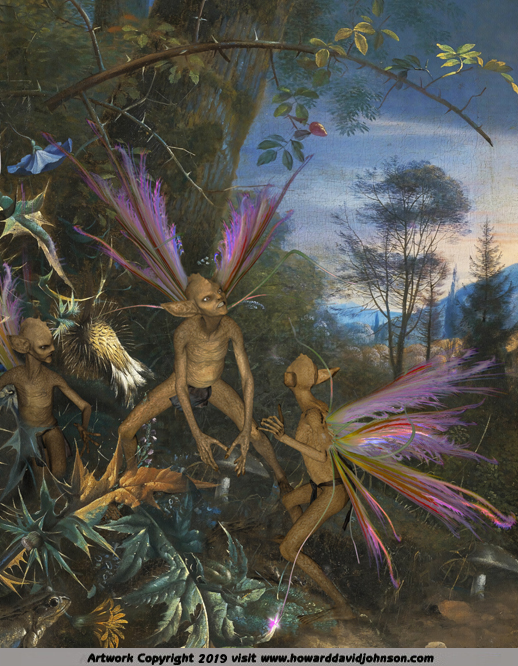 |
|
 |
| " Bad Fairies" | "The Gobliny Wood" | "Prospero's Fairies" Mixed Media MMXIX |
| Hobgoblins
or changelings were noted for shape-shifting and kidnapping children,
In ancient fairy folklore from the British Isles, the prefix hob- in a
creature's name often meant that it was smaller and friendlier than
other similar characters. Thus a goblin might be larger and more
vicious than a hobgoblin. Renaissance alchemists explained that fairy
creatures are formed from the subtlest ingredients from the four
elements that constitute the universe. For that reason, fairies are
also known as "elementals". A fairy circle unleashed great magical powers. The
evolution of the fairy tale and fairy painting continue to this
day.
THE FAIRY CIRCLE and MUSHROOMS There are many gateways to the magical land of Faerie, each with it's advantages and perils. Dreamers are the boldest explorers of the fairy kingdom, needing no transportation or maps. Contact with wild nature, unspoiled by man is another legendary pathway to the realms of faery. It is always a path wrought with uncertainty as even the most enchanting and beautiful fairy could suddenly transform into a hideous creature or dangerous old witch due to the slightest breach of the secret fairy code of etiquette or the elven code of honor.
|
||
|
"The Fairy Circle" ( 2004- Prismacolor pencils)
|
"The Protector of the Forest" (2012 oil on canvas) |
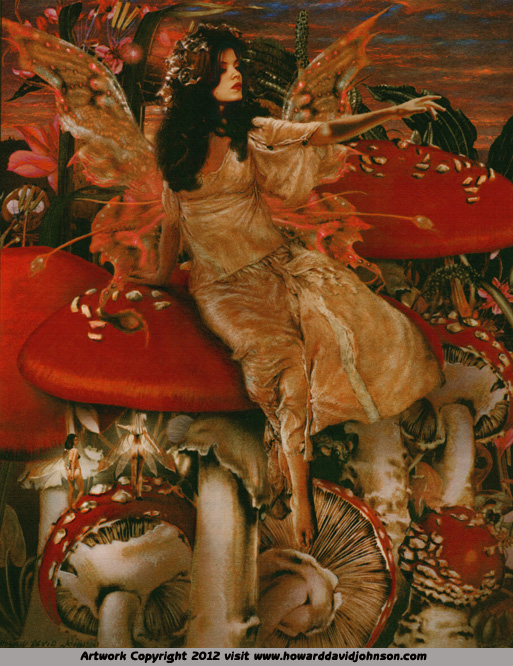
"Fairies" ( 2002-Prismacolor pencils) |
|
"The Fairy Circle" MMIV features Carmen Fron as it's model and is rendered in Prismacolor Colored Pencils - A 'Colored Pencil Painting' if you will, Because this kind of picture is really not at all what people think of when they hear the word 'drawing'. This art medium, these relatively new soft oil based colored pencils are not the first Dry Painting Medium: the term 'Pastel Paintings' originated in the 17th century. They also are a wet medium, mixing well with solvents and applied with an artist's brush getting very oil painting- like results. For more on the artist and other media employed, such as Acrylic and oil painting, pastels, photography and digital media, or essays on art history, style and technique, scroll past the main exhibit of fairy paintings to the bonus section... |
CLASSIC FAIRY TALES
Cinderella
"Poor Cinderella" MMX (above left) "The Fairy Godmother" MMXIV and "Queen Cinderella" MMVII Mixed Media
Fairies of William Shakespeare
|
Shakespeare's Faeries are Celtic Faeries, in "Romeo and Juliet" he muses of "Queen Mab, the bringer of dreams" - Celtic goddess and the original Fairy Queen. He influenced generations of writers to look from the overused Greek and Roman themes to their own Celtic Heritage. Shakespeare's "The Tempest" provided the inspiration for the next piece; The shipwrecked wizard Prospero's daughter Miranda at the tender age of fifteen surrounded by fairies, sprites, spirits and even specters of death all at her father's command. |
"Mab, the Bringer of Dreams","The quarrel between Titania and Oberon", and "The Tempest"
|
Of all Shakespeare's plays A Midsummer Night's Dream has had the most compelling hold on the imagination of painters. William Blake made a series of watercolor fairy paintings in the early 1790's. By the mid 1800's a tradition developed among British and Scottish Painters that continues today all over the world in every known media... This 21st century interpretation of Fairy King Oberon by Johnson is very Elven and martial in conception. Shakespeare's fairies are some of my favorites for creating fairy paintings. Above left is the dream from "A Midsummer Night's Dream" Above right we see the quarrel between Queen Titania and The Terrifying King Oberon. Did you know the original King Arthur was a Fairy King? |


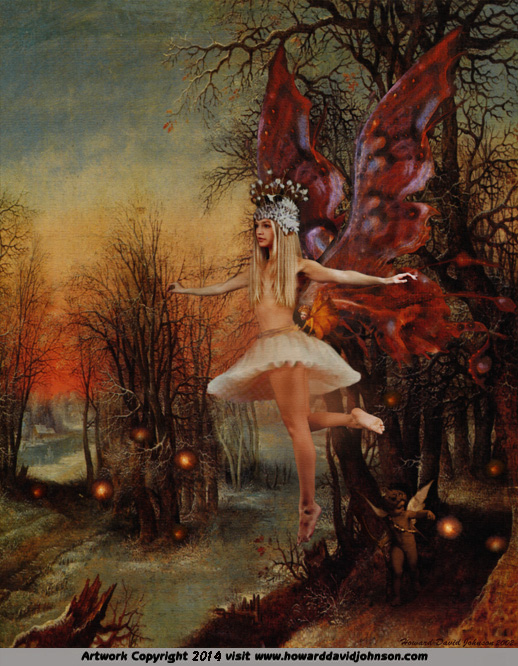
"A Midsummer Night's Dream", "The Toadstool Faerie", and "Faerie Twilight"
CELTIC FAIRIES
"Faerie Tales", "The Protector of the Forest" and "Celtic Queen Madbh" {Mave} (mixed media)
|
The Original Faerie Queen? The Heroes of Ulster, from Celtic Mythology, have no part in fairyland, but their enemy, Medb or Medbh, ( Pronounced 'Mave' ) above is credited with Queenly rule among the Sidhe ( Celtic Fairies ) & is held by some (not all) to be an evolution of the original Celtic Fairy "Queen Mab". I just had to do both! The braided Celtic knot work on her garments was believed to have magical powers to ward off evil spirits. The cauldron & standing stones are also key elements of Celtic folklore, the fountainhead of all fairy tales. |
Victorian Style Fairies
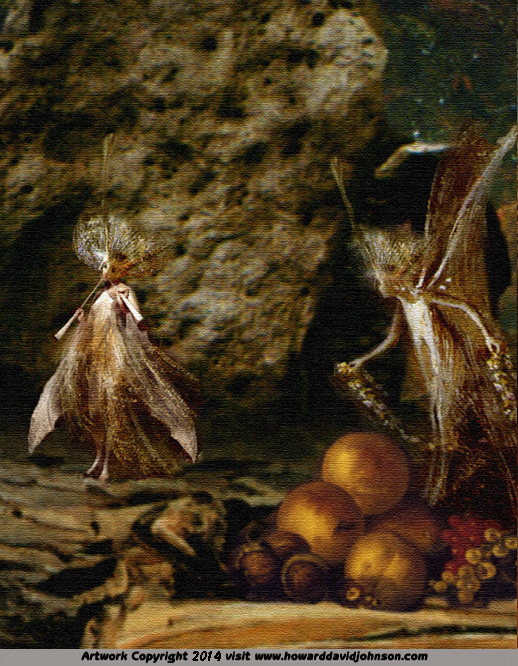
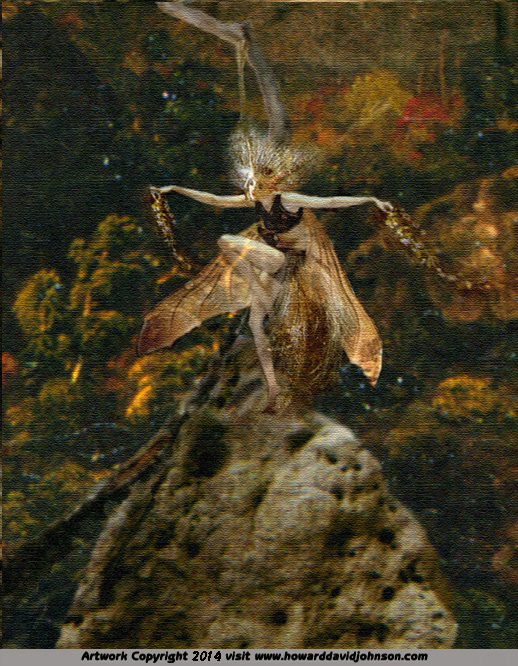
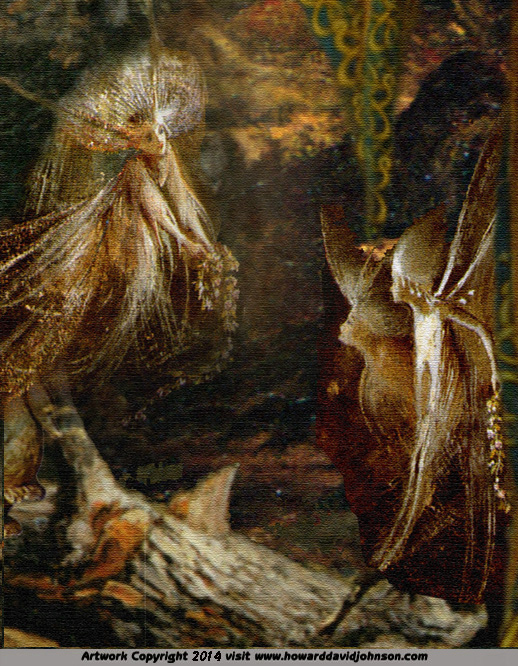
These detailed close-ups from Celtic Fairy Queen Mab (above) reveal the intricate detail in these Digital Fairy Paintings...
|
"The Little People" or Leprechauns were the a race of elves ( fairies ) from the folklore of the Irish. ( or Luchrupan ). They were master craftsmen and hoarded hidden treasure. As with fairies, contact with them could be a blessing or a curse. Over the course of a thousand years, the gods of the Ancient Celts (AKA the elves and fairies) evolved into what we now call the little people. Country People still commonly believed in them until the coming of the television in the 1950's... By the mid 20th Century belief in fairies was widely thought to have faded into history. |
Hurt Feelings" ,"Fairies goblins and Dwarfs" MMV and "The Red Fairy" (mixed media)
|
One of the chief attractions of fairy paintings for the Mid-Victorians was that it made possible highly realistic and revealing pictures of the female form that would have otherwise been inadmissible... Thus, I am Continuing in a very real part of the tradition of Victorian Fairy Paintings with innocent, natural, and mild portrayals of the uncovered human form... these fairy pictures are not displayed here. The Classical or Greco-Roman school of art is distinguished by the notion that the human form is the ultimate arena for artistic expression. |
"Faeries, Pixies and Elves of the Old World"
"Forest Pixies", Midnight Fairy" and " The Fairy Grove - Revisited"
More Victorian Style Fairies
|
For more than six thousand years, the Faerie, the Toad, and the Mushroom have been associated with Shamanism and the ancient Pagan religions of Europe... in spite of persecution and the ridicule of modern science these practices continue to this day. In the 21st century revivals of nature spirit worship are appearing all over the world and fairy folklore is as well loved as ever...
|
By Popular Demand! So many have written asking how to tell the various art media apart~ But friends! That's JUST my point!
Left Digital Montage, Center: Prismacolor Painting, Right Oil on canvas
So faire and fresh, as freshest flowre in May; For she had layd her mournefull stole aside, And widow-like sad wimple throwne away, Wherewith her heauenly beautie she did hide,Whiles on her wearie iourney she did ride; And on her now a garment she did weare, All lilly white, withoutten spot, or pride, That seemd like silke and siluer wouen neare, But neither silke nor siluer therein did appeare.

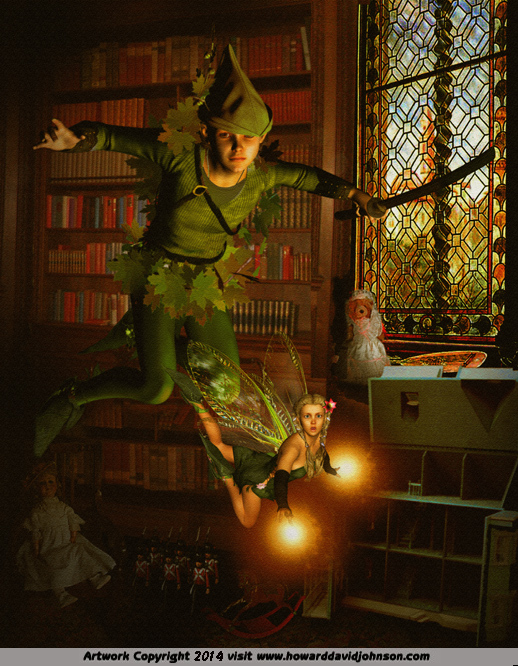

"The Blue Fairy ", "Peter Pan" and "Horror of Tinker Bell"
|
"I love illustrating fairy tales like Peter Pan, Sleeping Beauty, and Cinderella. The Brothers Grimm, Jakob (1785-1863) & Wilhelm (1786-1859) actually did not originate those stories but re-invented them for a new era by collecting and editing them into a book called "The German Book of Popular Stories", much like Aesop collected the fables of the Greeks. In the 20th century Walt Disney Re- invented Fairy Tales like Cinderella and others in his wonderful animated films. |
"In reality there were only bloody faery tales. The origins of every faery tale are steeped in blood and fear."
~Franz Kafka
Thank you for visiting the Fairy Paintings Art Gallery of Howard David Johnson...
This page is lovingly dedicated to the Immortal British and Scottish artists whose Fairy Paintings who inspired me...
Music by Peter Ilyich Tchaikovsky ( 1840- 1893) - "Swan Lake"
Enter a world
of Beauty and Imagination... INDEX of GALLERIES ~ LINKS to LARGER ART The
Realistic and Fantastic Art Galleries of Contemporary American
Illustrator Howard David Johnson Click on
these Fun Educational
Realistic Art Gallery link icons for Two-fisted Tales of VALOR
&
Frontline Combat featuring Legendary Warriors of History, Knights and
ladies of
Arthurian Legend, Celtic, Nordic, Asian and Olympian gods &
monsters,
unicorns, dragons, fairies... and more! All these pieces of art and the text are legally
copyrighted and were registered with the U.S. Library of Congress
Office of Copyright by the author, Howard David Johnson All rights
reserved worldwide. Permission for many academic or non-commercial
uses is freely and legally available by simply contacting the author
via e-mail or visiting www.howarddavidjohnson.com/permission.htm Who
is American Artist Howard David Johnson? In
one of David's invitations to the
Florence Biennale Contemporary Art Exhibition, (a partner in the United
Nations'
Dialog among Nations), UN Secretary General Kofi Anon wrote him:
"Artists have a special role to play in the global struggle for peace.
At their
best, artists speak not only to people; they speak for them. Art is a
weapon
against ignorance and hatred and an agent of public awareness... Art
opens new
doors for learning, understanding, and peace among nations." A portrait of the artist in his painting
studio.
David's Traditional Realistic Art was exhibited in the British Museum
in London in 1996, ( 3 years before he got his first computer ) as well
as numerous American ones since, such as the Metropolitan Museum of
Art. David's realistic illustrations have made appearances in
every major bookstore and game shop chain in America as well as
magazines and educational texts around the world.
Some of his more prestigious clients
have included the National Geographic Society, the University of Texas,
the University of Cambridge in England, Paramount Studios, Universal
Studios, PBS TV, Enslow Educational Publishers, Adobe Photoshop, Auto
FX, Doubleday, the History Book of the Month Club, & J Walter
Thompson Advertising, just to name a few. Working in a
variety of media David offers his customers a variety of options and
more than three decades of experience. The Flower Fairy This Art Gallery has been honored by more than 35 million
Unique Visitors from the Four Corners of the Earth: My Friends from around the world
thus far : Ireland, Scotland, Wales,
Germany, Canada,
England, France, Monaco,
Andorra, Italy, The Vatican City State,
Greece, Macedonia, Cyprus, Turkey,
Belgium, Denmark, The Faroe Islands,
Greenland, Yugoslavia, Macedonia, Croatia, The
Czech Republic, Bosnia, Herzegovina, Slovakia,
Slovenia, Luxembourg, Latvia, Estonia, Hungary,
Bulgaria, Lithuania, Poland, Austria,
Romania, Spain, The Russian Federation,
Ukraine, Kazakhstan, Moldova,
Malta, Iceland, Finland, Norway,
Netherlands, Switzerland, Liechtenstein,
Sweden, Portugal, Albania, Armenia, Georgia,
Azerbaijan, Belarus, Kazakhstan, Gibraltar,
Israel, Palestinian Territories, Egypt,
Libya, Mali, Algeria, Niger, Saudi Arabia,
Oman, The United Arab Emirates, Kuwait,
Bahrain, Qatar, Yemen, Iraq, Iran,
Jordan, Syria, Lebanon, Morocco,
Ethiopia, Eritrea, Liberia, The
Republic of Congo, Rwanda, Kenya,
Angola, Ghana, The Ivory Coast,
Zambia, Zimbabwe, Sudan,
Nigeria, Namibia, Uganda, Kenya,
Eritrea, Tanzania, Botswana, Malawi,
Senegal, Djibouti, Cameroon, Chad,
Gambia, Mozambique, Swaziland, Lesotho, South
Africa, Viet Nam, Japan, South Korea, China,
Hong Kong, Macau, Mongolia, Mauritius,
Singapore, Thailand, Cambodia, Laos, Myanmar,
Macau, Malaysia, Taiwan, Nuie, New
Zealand, Fiji, Cook Islands, New Caledonia,
Vanuatu, American Samoa, Australia, Micronesia,
Polynesia, Papua New Guinea, The Heard and McDonald
Islands, The Philippines, Guam, Palau, Cocos Island,
The Kingdom of Tonga, Malaysia, Brunei
Darussalem, India, Pakistan, Afghanistan,
Bhutan, Bangladesh, Sri Lanka, Chagos Islands,
The Republic of Maldives, Turkmenistan, Kyrgyzstan,
Uzbekistan, Nepal, Indonesia, Chile, Argentina,
Uruguay, Paraguay, Brazil, Peru,
Aruba, Venezuela, Bolivia, Suriname, Guyana,
Aruba, The Dominican Republic, Guatemala, Costa Rica,
Colombia, Trinidad and Tobago, Antigua and
Barbuda, Barbados, The Virgin Islands, The Netherlands
Antilles, Panama, Saint Vincent & Grenadines, Grenada,
Ecuador, Belize, Nicaragua, El
Salvador, Bermuda, Cuba, Jamaica,
Dominica, Haiti, Puerto Rico, Cayman
Islands, Anguilla, The
Bahamas, Honduras, Mexico, and my home, The Great Free State of Idaho... If your home is not listed here please e-mail
and tell us where you're from... **** With
a background in traditional media including oils, pastels and colored
pencils, Howard David Johnson embraces leading edge digital media in
the creation of his depictions of fairy tales, folklore, mythology,
legend, religion, and heroic history. He works in and mixes a wide
variety of media * Oil paintings * Acrylic Paintings * Prismacolor
Paintings * Drawings * Chalk & Oil Pastel Paintings * Photography *
and last but not least: Digital Artistry & Mixed Media *
(Publishing Licenses of existing works and commissions
for new ones are available. All these fairy
paintings &
text are legally copyrighted & registered with the U.S.
Library of Congress
Office of Copyright by the author, Howard David Johnson All rights
reserved
worldwide. Permission for commercial uses is available. Contact the
artist for friendly service or visit www.howarddavidjohnson.com/permission.htm) Publishing Licenses & Original oil paintings are for
sale, e-mail for courteous Service... We LOVE hearing from you...
Gorgeous
Poster Size Reprints of Johnson's Fairy Paintings are Now Available!
Essays and Articles
Section:
Philosophy, Art, & Art
Philosophy
Personal Opinion Essays on
Realism yesterday and today by the artist.
David Johnson is an outspoken proponent of mechanical aids to visual
art. Unlike the opponents of mechanical aids, his mission is not to
prove his talent but to help preserve our vanishing Western cultural
heritage. In addition to his mastery of the traditional media, now
combines drawing, painting, photography, and digital media with more
than thirty years of experience in these fields to create his Realistic
Art Numerica in 21st century paintings and pictures. Did you know the Greek word "Photography"
means "Painting with Light"? Today with the advent of computers it
truly lives up to it's name. Due to developments in Art and Technology,
a broader definition of painting is needed than that which is found in
common usage. Introducing Art Numerica- an exciting merger
of traditional visual art and cutting edge technology... a new art form
for the twenty- first century... Art Numerica is not limited to
realistic art but also offers limitless horizons for everything from
cartoons to abstractions. It
is the most dramatic development in the visual arts since the
Renaissance. What is YOUR definition of Art? Essay
One: "THE MORE THINGS CHANGE, THE MORE
THEY STAY THE SAME..."
"Painting, in art, the action of laying colour on a surface, or the
representation of objects by this means. Considered one of the fine
arts" ~Encyclopaedia
Britannica.
"Painting. noun. 1.) The act or employment of laying on colors or
paints. 2.) The art of forming figures or objects in colors on canvas
or any other surface, or the art of representing to the eye by means of
figures and colors any object; the work of an illustrator or painter.
3.) A picture; a likeness or resemblance in shape or colors. 4.) Colors
laid on. 5.) Delineation that raises a vivid image in the mind; as in
word painting. ~
Webster's Unabridged Dictionary of the English Language Pastel, Acrylics, and Colored
Pencils combined
Snobbism in the arts is nothing new. Some people will tell you
that oils are the only valid medium for realistic paintings. That
Colored Pencil, Digital, and other Realistic Painting and Drawing Media
are not valid for "real" art. Young artists, Don't let them
bother you. Their forerunners used to condemn Pastels before they
gained acceptance and called them "crayons" when Johann Alexander
Thiele (1685-1752) invented them. Mercilessly disrespectful
art critics of the time could not stop the Experimentalists no matter
how viciously they attacked and derided them. "Crayon-painting" as it
was called in England was practiced early on by persecuted pioneers in
Switzerland and many other nations. What a debt we owe to these master
artists who refused to knuckle under to the pressure of those
short-sighted critics during those historic and experimental times. It
took until 1870 with the founding of the "Societe` Des Pastellistes" in
France that respect came at last to these heroic & immortal
visual artists.
In England the liberation of the Pastellists from slight regard
and undeserved disrespect came with the first exhibition of "The Pastel
Society" at the Grosvenor Gallery in 1880. Pastel Painters like
Mary Cassat and others from America and other nations forever
silenced the snobs with their masterworks and gained recognition
at long last for Thiele's invention as a valid art medium. I am
persuaded that history will repeat itself. Like Pastels, I
believe these wonderful new colored pencils and even Digital Realistic
Art Media will one day receive the recognition they deserve as powerful
mediums of artistic expression just as pastel paintings did. What is
your definition of art? Have you thought about it? Mine
is: "anything that makes you feel or think."
Consider dancing... it can be a little skip in the step or rise to the
level of the incomparable Russian Ballet. Did you know that just the
materials alone for a single oil painting cost up to a thousand dollars
these days? Even paying the artist less than minimum wage no one but
the super rich can afford them anymore. Something's got to give.
Realistic paintings in oil have been highly prized for centuries and
the appeal and following of realistic art is undiminished to this day.
Oil paintings featuring Abstract Art and Realistic Art are generally
the most treasured form of all the visual art media and with good
reason. But snobbish art critics favoring abstract art have
declared that realistic paintings, or illustrations are not art
for a century. With so many representationalist paintings by so
many immortal master artists hanging in the Louvre, the Hermitage, and
the British Museum and others I think the disrespect for realistic
illustrators that dominated the 20th century is academically ridiculous
as well as vain and intolerant, insisting theirs is the only valid
opinion. What is your definition of Art? I believe almost any
form of human expression can be raised to the level of "high art"
especially visual art and Realistic illustration... The detail
reveals Realistic art and abstract art combined
By my own definition of art, which is:" anything that
makes you feel or think" most abstract paintings are not "real art" to
me personally, because abstract
paintings usually neither make me feel or think, usually focusing
obsessively on technique and avoiding any coherent content. I usually
draw a complete blank mentally and emotionally when I look at them. In
1979 the Houston Metropolitan Museum of Art displayed a triptych of 3
giant paintings they paid fifty thousand dollars for-
three blank white canvasses entitled "untitled". Then there was "The
incredible new artistic Genius" with an I.Q. of 62 ...Congo the
chimpanzee with his gala New York art exhibition...an elaborate prank
played on the Snobbish American Art critics about a generation ago by
research scientists in the field of primatology. Imagine how upset they
were when he created one of his "ingenious masterpieces" right before
their eyes. ( My
Source for this is the Time Life Science Library volume entitled "The
Primates". )
Art education has been almost completely removed from
American Schools as a result of generations of this kind of
fabulous nonsense contributing to America's cultural illiteracy crisis.
Now, the works of Leonardo Da Vinci, Michaelangelo, and other notables
are being removed from school libraries. After generations of
this, most American college graduates today cannot name even one living
visual artist, abstract or realistic. There is
no way that mandating more math, requiring more reading, or scheduling
more science will replace what we have lost as a
culture. What is
your definition of Art? ~HDJ ***** Essay
Two : The Rebirth of Realism More
thoughts on realistic art yesterday and today by the artist Art History has
entered a new era with the birth of Art Numérica, or digital art media
in the 21st century. Artists never stop exploring with mediums. Artists
have been developing techniques, experimenting with different tools
since at least twenty- five thousand years ago, when the first artist
picked up a charred stick and scratched a picture out on the wall of
his cave. You'd think everything would have been tried by now, but it
hasn't. Exploring new mediums this very day is just as exciting, just
as full of freshness and newness as it ever was.
Early abstract art masters proved
themselves as realistic artists before delving into realms of the
intangible. They had to do this at that time to prove themselves
because of the challenges they faced from the establishment for going
against the status quo. In the latter part of the 20th century,
realistic artists like HDJ were challenged to do abstract art to prove
themselves as shown in the example above (Deirdre of the sorrows).
Later realistic art training was abandoned in most schools and things
like splattering paint in fits of rage were deemed more than
enough. By the end of the 20th century something as destructive and
ridiculous as nailing a pack of cigarettes to a shoe was considered
fine art but not realistic paintings. Fashions in art have often been
as silly as fashions in ladies hats. As the century drew to a
close, many people had had enough. The realistic revolt was at hand.
The rebirth of realism was fueled by the advent of the digital era.
Now, for the first time in almost two centuries, an artist or
illustrator could earn a decent living again with his realistic art.
This is historic. Realistic art is not going to go away, especially now
that photography has truly merged with traditional realistic paintings.
Photography comes from the Greek words meaning "painting with light".
Now with the advent of digital media the capability of realistic art
has become almost limitless, truly, "painting with light". The merger
of all the world's art forms to realize the potential of motion
pictures has come now to still realistic art media. This website for
example, combines music, prose, poetry, photography and traditional
realistic art media to create an experience beyond merely looking at
realistic paintings.
The twenty- first century is already seeing a
new renaissance in the arts because of the world wide web. There has
never been anything like it. Abstract art, computer art, photographic
art, and realistic painting are continuing to be separate schools of
art but are also blending to create exciting new horizons. Although
Digital art does offer completely new horizons to the artist in the
21st century it does not mean the end of our time honored art
traditions. Instead, it offers additional ways to keep these traditions
and schools of thought fresh and alive. ~ HDJ ***** STYLE and
TECHNIQUE "Those
who are enamored of practice without science are like a pilot who goes
into a ship without rudder or compass and never has any certainty where
he is going. Practice should always be based upon a sound knowledge of
theory, of which perspective is the guide and gateway, and without it
nothing can be done well in any kind of painting."
Since
boyhood he has passionately copied the old masters. To create his fairy
paintings, he usually starts with a thematic concept followed by
a rough realistic pencil sketch, then followed by his original
photography, often traveling to find suitable scenes and locations and
then working in his Photography studio with live models from his
sketches. He then assembles a variety of elements which are realistic
and original. As a boy he dedicated his life to art in 1960. From
1965- 1999 he used xeroxes and tracings to make his preliminary
collages. This is patterned after the manner used by Maxfield
Parrish and other 19th century notables. Beginning with a tracing, he
then draws or paints from these new complex original Computer Photo
Montages. Many of these are on display on this web and slated for
future completion in a variety of traditional art media. As this
happens, the finished painting is substituted in the exhibit. For
decades David has sought out the most beautiful models and brought them
in for sessions in his analog photography studio. Using a strategy
employed by J. W. Waterhouse, (the old master David imitates most )-
his wistful and graceful models cannot be underestimated in their
contribution to the stunning beauty and the potential for lasting
appeal of his work.
His favorite medium for Fairy Paintings is colored pencil because of
the high speed and low expense, and people began expressing difficulty
in telling his 'Prismacolor paintings' from photographs in the early
1980's. In the last 35 plus years he has also mastered Oils,
Pastels, Acrylics, Watercolors, Inks, Scratchboard, Gouache,
Photography, and the highly controversial digital media. As a
commercial illustrator David has not only used the computer to create
art but has been involved in the development of computer imaging
software for Adobe Photoshop. Working in a realistic style inspired by
classic illustrators David is deeply rooted and grounded in the
Greco-Roman artistic tradition, Feeling that with realistic art, the
human form is the ultimate arena for artistic expression. His lifelong
dream came true when his Traditional Realistic Art was exhibited in the
British Museum in London England in 1996. His mixed media has also been
displayed in numerous other ones since such as the Metropolitan
Museum of Art. Having achieved international acclaim as a traditional
visual artist he discovered digital media ( Art Numérique ) in
1999. Because of his passion for realistic art and photography he
elected to embrace it and joyfully be a part of this historic era in
the visual arts as a 21st century realistic visual artist. Only
David's finest fairy paintings are ever rendered in oils
Since 1972 when he began his career as a scientific illustrator for the
University of Texas he has earned his living illustrating all kinds of
books, magazines, CD covers, and all sorts of games, greeting cards,
calendars, portraits, murals and the like with his contemporary
realistic art... HDJ's Realistic Art has appeared in every major
bookstore chain and fantasy gaming shop in The United States and has
been used in educational texts and magazines all over the world. This
site features realistic paintings & pictures for the twenty-first
Century including some oil paintings, as well as lots of
other exciting media such as colored pencil drawings, pastel paintings,
acrylic paintings, gouache paintings, watercolor paintings, and pencil
drawings, and also featuring studio, field, & aerial
photography, digital painting and photo-montage and all these
media mixed in an assortment of experimental combinations. In addition to his mastery of traditional
media, Howard David Johnson now combines drawing, painting,
photography, and digital media with more than thirty years of
experience in these fields to create his 21st century fairy paintings
and pictures. Did you know the Greek word "Photography" means "Painting
with Light"? Today with the advent of computers it truly lives up to
it's name. Due to developments in Art and Technology, a broader
definition of painting is needed than that which is found in common
usage. Announcing Art Numérica -an exciting merger of traditional
visual art and cutting edge technology... a new art form for the
twenty- first century... Digital Art media is not limited to realistic
or fairy art but also offers limitless horizons for everything from
cartoons to abstractions. It is the most dramatic development in the
visual arts since the Renaissance. Working in a wide variety of
media to create his fairy art he offers his customers a host of payment
and product options. He delivers the rights to these custom made
copyright free illustrations and old fashioned customer service when he
does work-for-hire. He loves to paint custom oil paintings and accepts
commissions with down payments starting at one thousand dollars. Other
media, like colored pencil or digital are less expensive. On existing
works licenses start at only $100. ***** 2006
Artist's
Statement:
"Did you know that many of the breathtaking works Pre-Raphaelites were
doing in oils in the 1800’s were declared not to be Art? In London the
Royal Academy had a very narrow view as to what qualified. No wonder
Rossetti led a revolt
against them. How about Styles? Impressionism is a great example; It
was not
enough that these institutions rejected the work, but they felt the
need to
destroy the person’s reputation and livelihood. Of course collectors
pay
millions for these Impressionistic paintings now, and Curators,
Historians and
Professional Art Critics all hail them as sensitive works of fine art.
When
Monet submitted his work to the Salon in Paris, they said" A monkey has
gotten a hold of a set of paints" and would paint huge "R"s for
"rejected on the back canvas. Rejecting him was not enough for them.
They
wanted to be sure he never sold another picture. They wanted to hurt
him and his
family for sick sadistic pleasure. He got really good at re-stretching
his
canvas with a double layer to cover up their hateful defacement of his
original
art. They saw themselves as powerful as the deadly committee for public
safety
in the French Revolution as far as the Art World went and delighted in
"sending artists to the guillotine", so to speak. These hateful little
petty tyrants were unable to keep his name out of the history books or
to keep
his paintings for selling for millions of dollars. This is the
treatment someone
who creates a new style gets, but developments in applied technology
like
manufactured tube paints as opposed to hand mixed paints were violently
rejected
by these types as well and they forcefully proclaimed anyone who used
paints
from a tube was not a "real artist". Well, tube paints are pretty well
accepted now. So will photography and digital media in time. You
probably
know how bad Photographers were treated, but
now it is a respected Art
Form. I Remember the hateful things they said about Pastels and Mary
Cassat, and
now Pastel Paintings are considered Fine Art and Mary Cassat’s works
are
regarded as masterpieces. Now that snobs have Digital Artists to look
down on,
Colored Pencils are starting to get some respect. Our day will come."
~ Howard David Johnson All these fairy
paintings &
text are legally copyrighted & were registered with the U.S.
Library of Congress
Office of Copyright in 2014 by the author, Howard David Johnson All
rights reserved
worldwide. Permission for many legal non-commercial uses is freely
available by simply
contacting the author or visiting
www.howarddavidjohnson.com/permission.htm ***** If your browser ever stops loading fairy Art click
refresh
Essay
Six: Copyright
Law and the Visual Arts in the Computer Age An
introduction to the Millennial Copyright Act for Artists A
brief, easy to understand essay in layman's terms on
21st century legal boundaries, guidelines, and western art traditions
by the artist
"All art is
ultimately some form of imitation, even if you are an expressionist
painter imitating an
abstract vision in your own mind. These new visual art creations of
mine take their
inspiration in part from the realistic paintings of the old masters
just as The Lord of
the Rings comes from The Ring of the Nibelung and European folklore and
West Side Story
came from Romeo and Juliet, which was in turn inspired by Antony and
Cleopatra. Much as
Rubens copied Titian, I copy Waterhouse and so on. Over the last 300
years,
ideas about female beauty have drastically changed and this has caused
many of the most
wonderful paintings of the old masters to seem 'ugly' to youthful
modern audiences. For
example, in the days of Peter Paul Rubens, being forty to sixty pounds
over-weight was
considered not only attractive, but was a status symbol. Beauty is in
the eye of the
beholder and tastes have clearly changed. I feel many classic themes
need to be redone to preserve interest and appeal for future
generations. This has
happened many times before as artists like Aesop, The Brothers Grimm
and Walt Disney have
appropriated, modified, and re-defined elements of our culture to
preserve it for future
generations. The legality of such use today depends on whether or not
the source is
protected by copyright law. You can draw or paint Shakespeare's fairies
for example and
publish them without permission but not more modern intellectual
properties like
characters from Star Wars or Mickey Mouse who holds the oldest
copyright dating from 1928. Our
shared cultural heritage, great works of art, literature, music and
drama, cinema, folk
tales and fairy tales are all drawn upon again and again by the
creators of new works.
These works in the public domain are both a catalyst and a wellspring
for creativity and
innovation. Even though all my Realistic Paintings are legally new
works and
protected under copyright law their inspiration comes in part from
works in the
public domain. The
public domain is a space where intellectual property protection (
copyright ) does not
apply. When copyrights and patents expire, innovations and creative
works fall into the
public domain. They may then be used by anyone without permission and
without the payment
of a licensing fee. My
sources have been transformed so much in the creation of these new
works of art that they
would not violate an existing copyright even if they were so protected.
Publicly owned national parks are also considered by many
to be public domain lands. Because of the recent extensions of the
terms of both
copyrights and patents, and the privatization of lands and other
resources owned by the
Federal Government, little is now entering the public domain. Look for
new litigation and
another time extension when Disney Corporation's Mickey Mouse copyright
is due to expire
in 2023. Where would Walt Disney be without the Fairy Tales of the
Brothers Grimm, Hans Christian Anderson,
or Victor Hugo? Where would Aaron Copeland have been without American
folk music? Thomas
Nast's Santa Claus without traditional images of Father Christmas?
Picasso without African
art? These are artists who made names
for themselves and even fortunes through Public
Domain appropriation, one and all. Some people are
actually outraged that there are some intellectual properties that
corporations do not
own. They feel appropriation is only appropriate if a corporation does
it. Corporations
created by public domain appropriation, now are the most powerful force
on Earth trying to
put a stop to new things entering the public domain forever through
lawsuits. The public
domain is a space where intellectual property protection ( copyright )
does not apply. It
was set up by our founding fathers, who felt creativity needed to be
rewarded on a
personal level for a time, and when copyrights and patents expired,
innovations and
creative works moved into the public domain.
Since the public domain is a treasure trove of information and
resources to be used by
future generations, many advocates are concerned that its stagnation
will make it more and
more difficult for future generations to find creative inspiration.
This
is least likely to hurt the motion picture companies who produce new
works
"in house" granting themselves permission, but the music industry which
brings in artists and new songs from the outside is being hit very hard
already. If a new song release resembles an old one, now there is
litigation. Visual Art Tradition
and etiquette suggest the most influential pieced borrowed
from the public domain should be mentioned at exhibits; these original
new
pieces Shown in my exhibits take their inspiration in part from the
paintings of
Waterhouse, Alma-Tadema, Moreau, Bouguereau, Leighton, Ingres, Moore,
Parrish, Rackham and
others. They showcase some of my favorite models. As a student of
fine art, copying
is a great way to learn and create fine art, but as a professional
illustrator things are
very different. Works done by artists out of personal motivation belong
to the artist who
created them, and they can sell licenses for divers forms of
publication. The law is clear
and simple regarding illustrations done for gainful employment. They
are called
"work-for-hire" under the law, and the rights to such works envisioned
by the
customer and specifically commissioned and paid for belong exclusively
to the customer and
the artist must specifically ask permission to ever legally use their
own work themselves.
Most people in this industry will be glad to give that limited
permission if asked. My art is
divided into two distinct groups; personal work partially copying the
old masters and
professional illustration applying these lessons to create totally
original works. I start
more often with a specific written request. This is the exact OPPOSITE
approach to
creating a picture from copying something that's there. Research
comes first. In the case of my illustration of the Spartan Warriors,
there were no
accurate sources in the public domain to copy correct Greek armor and
weapons in combat
poses from. Mostly I found images of effeminate men, wearing
nothing but a robe over
the shoulder and the wrong helmets. Finding history books at the
library with the accurate
helmets, shield designs, weapons, and armor was essential to get an
accurate depiction of
a Greek Hoplite. All the library had were stiff museum poses of
anything, but I hit
the research jackpot with some very simplistic flat line drawings of
great authentic Greek
shield designs. All the
elements must be found, gathered and assembled to create the dramatic
action scene the
client wanted. Next comes the layout. This is where the mathematics and
geometric design
come into the creative process. My wife, Virginia took a picture of me
nearly twenty years
ago on a carpentry project with the heroic Jack Kirby like pose I was
looking for mixed
with the texture and feel of a Frank Frazetta or Norman Rockwell
painting. Naturally, in
these cases I go to great lengths to make sure that my work looks
nothing whatsoever like
it's various inspirations and sources except in flavor and spirit. Of
course, the
characteristic old master's painting feel to the background most of my
illustrations have
was requested, and the picture was to have the flavor of a Howard Pyle
painting.
With regards to use of mechanical aids to create art: Did you know the
old masters traced?
To create his immortal "Mona Lisa" Leonardo Da Vinci used "Camera
Obscura" which is two mirrors set at 45 degree angles around the
corner with
parchment over it to trace onto. Michaelangelo used a similar technique
for the Sistine
Chapel. Think that makes it too quick and easy? You'll find once you've
finally got that
outline done right you're a long, long, way from being finished in any
medium... if these
men who set the standard for realistic excellence used them, why
shouldn't those who come
after them be permitted? Simple, because this is one of the most
carefully guarded
"secrets of the old masters" and most people don't know very much about
art
history... For more on Camera Obscura and the history of
photography and the use of mechanical aids to create art read essay
seven. When asked
why I usually work from photos I like to re-tell Norman Rockwell's
story about having to
paint a chicken: He set it up on a stump in a barn and goes to
painting. The chicken moves
it's head. He moves it back. The chicken jumps down. He puts it back.
He goes to paint.
now the chicken decides to make a break for it... he chases it down
clucking and screaming
and puts it back. Now it knows he's going to have it for dinner and it
goes completely
berserk. The next day, he came in and set the chicken back, snapped
it's picture, and the
photo held nice and still."
I have built up an enormous library of original 35 mm source photos for
use in my
realistic art. For decades I have been seeking out the most
beautiful models and
sometimes even their boyfriends and relatives, bringing them in for
sessions into my photography studio. The
law with regards to copy rights on photographs is simple - if you own
the negative you own the
rights. This new instant copyright without filing law is very nice for
photographers and artists working with their own photos, but not so
good for
free-hand drawings from the imagination and other non-photographic
based forms
of drawing and painting like cartoons. This is the main reason I use my
own photographs.
Using a strategy employed by J. W. Waterhouse, my wistful and graceful
fairy models cannot
be underestimated in their contribution to the stunning beauty and the
potential for
lasting appeal of my work. I am always make sure to both overpay them
for their time and
also the rights. I always get a written contract with the exception of
my dearest friends
and closest family who are always making cameo appearances. The models
get amenities and
services including portraits, portfolio photo sessions, photographic
reprints and
enlargements, leather presentation cases, webmaster services, original
art, and reprints
of their appearances in my drawings and paintings as well as above
scale cash payments at
the time of the shoot.
With regards to using
copyrighted material as a reference- When you have to paint a
wombat you can't fake
it- you need a picture! The law understands this and automatically
grants provision -
within reasonable limits; when using copyrighted sources the source
image
must be so transformed in overall appearance in the translation as not
to be
what the law calls "confusingly similar"...
If it's newer than 1928 you can bet it's probably copyrighted - they
had to renew exactly
26 years later in those days or it would pass into the public domain,
so it might not be
copyrighted if it wasn't a big moneymaker. Always be sure to check in
these cases. If it's
newer than 1999 under the millennial copyright act the law says it is
automatically
copyrighted without even filing. However, this new law is very tricky
in it's wording
because you must have already have filed with the copyright office in
advance if you ever
need to take legal action. They say it is copyrighted, but you
cannot sue
if it is not registered with the United States Library of Congress
Office of
Copyright. Because of this "instant copyright without
filing" clause, there is a serious danger of artists being made legally
helpless and left open to being cheated out of their work. From
an artist's standpoint, this is a huge improvement over the original 14
year
copyright term. When properly interpreted and acted upon, by filing
works with
the United States Library of Congress Office of Copyright, these laws
are GREAT for contemporary artists
and their estates, who will hold rights for seventy years after the
artist's death." ~ Howard
David Johnson M M I V ***** The Constitutional Provision Respecting
Copyright The
Congress shall have power... To promote
the progress of Science and the useful arts, by securing for limited
times
to Authors and Inventors the exclusive right to their respective
Writings and Discoveries. United
States Constitution Article I Section 8 ( This
essay is not meant to take the place of
expert legal council, but to introduce people to the basic concepts. ) If
you liked this Fairy Art
Gallery be
sure and visit Fairy Paintings II
and III above for
more costumed faery
pictures - featuring innocent faerie paintings and fairy pictures
suitable for all ages -
Thank you for visiting the faerie art
gallery
for fairy art faery art fairy
pictures digital
fairies faerie photos new fairies fairy paintings real faeries
fairy tale picture
gallery fairy illustrations faery pictures faerie paintings
contemporary faery art and
faerie photo art gallery faerie photo
art
new faerie art close-up faery art fairy pictures digital fairies
fairy paintings faerie photos
"Gyre-Carling, Queen of Elfland" exotic fairies new
faeries the fairy tale picture
gallery of Howard David Johnson... info@howarddavidjohnson.com Thank you for Visiting... Your business, letters, & links
are always welcome. ***** Art tradition and etiquette suggest the
artists who have been most influential should be mentioned at exhibits;
these original new pieces shown in this exhibit take their inspiration
in part from the paintings of Waterhouse, Alma-Tadema, Church, Godward,
Moreau, Bouguereau, Leighton, Ingres, Moore, Parrish, Rackham and
others. Most of my sources are changed so much they are impossible to
detect, but sometimes I make it obvious to pay homage. Where would Walt Disney be without the Brothers Grimm,
Hans Christian Anderson, Victor Hugo and so many others? Where would
Aaron Copeland have been without American folk music? Thomas Nast's
Santa Claus without traditional images of Father Christmas? Picasso
without African art? These are artists who made names and
fortunes through Public Domain appropriation, one and
all. Beethoven did "variations on a theme" with the works of
Mozart for the same reasons I have done mine with Waterhouse and
others- to learn and give homage to the artists who most inspired
me. Commercial Licenses are available for these - If your
browser stops loading fairy Art click refresh Thank
you for visiting the Fairy
Paintings Art Gallery of Howard David Johnson... This page is lovingly
dedicated to the Immortal British and Scottish artists whose Fairy
Paintings who inspired
me... Music by
Peter Ilyich Tchaikovsky (
1840- 1893) - "Swan Lake"


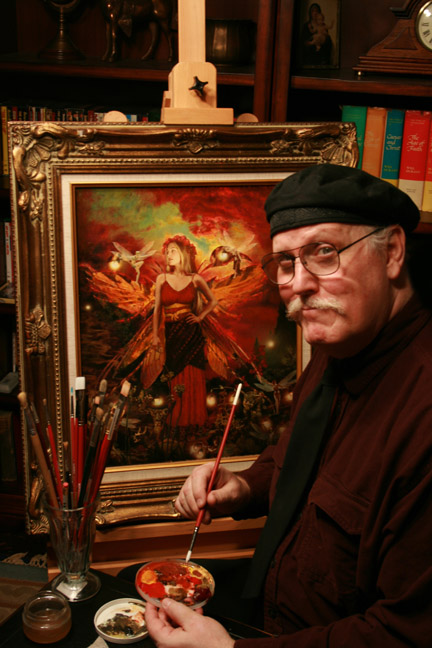
Howard David Johnson
is a contemporary realistic artist and photographer with a background
in the natural sciences and history. After a lifetime of drawing
and painting, David works in a wide variety of mixed media ranging from
oil on canvas to digital media.
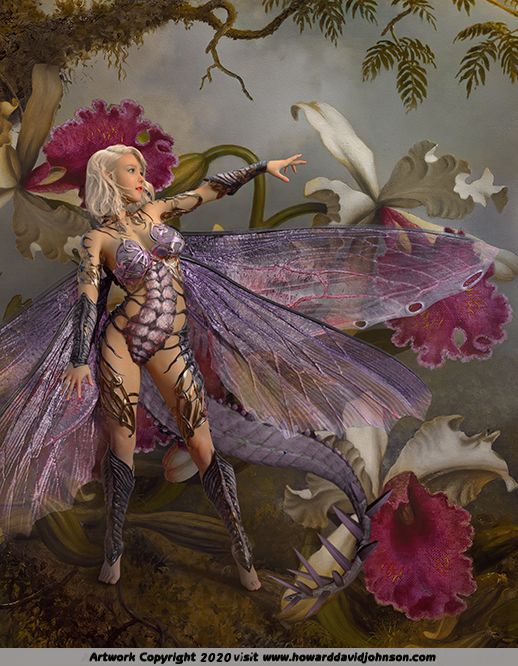
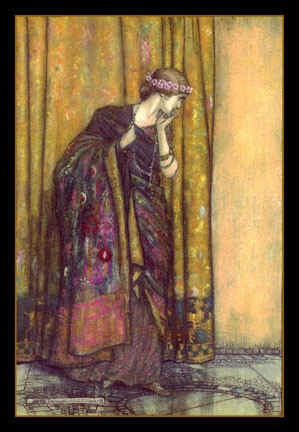

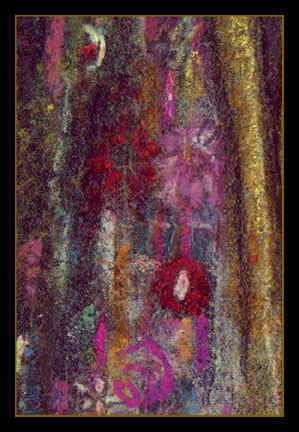
Note: Abstract Paintings by
Congo the Chimpanzee outsold Warhol and Renoir by over 25,000 dollars
in June 2005 at a London art auction. Born in 1954, Congo created more
than 400 drawings and paintings between the ages of two and four. He
died in 1964 of tuberculosis. There is no precedent for this kind of
sale.
The creation
of Realistic art has been the goal of most artists since the dawn
of civilization. Realistic art was the pride of ancient Greece.
The world's greatest museums are full of realistic paintings. Realistic
art WAS art until the advent of the abstract expressionist movement in
the twentieth century. The coming of the camera in the nineteenth
century changed realistic painting forever. Suddenly, realistic
painting was not the only way to create realism in portraits and
historical records. The work of the realistic artist was suddenly made
into an expensive luxury. The political power of the realistic artist
was broken and they were no longer an indispensable member of
society. Hostility to the creators of realistic paintings and
statues goes back to ancient times and the jealousy of advisers to the
Pharaohs and others who were not able to spend as much time with their
rulers as their portraitists. Although with the aid of photographs,
realistic art achieved levels of excellence undreamed of, the realistic
art movement of the late nineteenth century was short.
None of these people earning their living creating realistic art could
compete with the speed and low cost of photographic portraiture.
Determined to survive, great realistic artists like Pablo Piccaso
ingeniously turned inward and began to explore things that could not be
photographed in a new school of art, abstract expressionism. The day of
the fine art superstars had arrived. It was now largely just a hobby to
abstract and realistic artists alike. Illustration, because of advances
in printing technology enabled an elite few to earn a living with their
realistic art. These illustrators working in realistic art media
were condemned and ridiculed in much the same way Europe's great
symphonic composers were condemned for working in motion pictures after
fleeing the nazis during World War Two. The rift between realistic and
abstract art grew wider and wider. The universities and key media
usually sided with the abstract camp and derided anyone working in any
realistic art media declaring boldly that realistic art was not "real"
art. Immortal giants of realistic art such as Maxfield Parrish were
mistreated their entire lives. They were accused of selling out for
creating beautiful pieces of realistic fine art to earn a living. The
attitude that the true artist must suffer and starve and die in poverty
became a rule. There were the Abstract art superstars, the professional
realistic illustrators, and the hobbyists who, although cut off from
gainful employment and social influence still recognized their artistic
gifts as a calling rather than a profession.
Howard David Johnson is a contemporary artist
and photographer with a background in
the natural sciences and history. He works in
a wide variety of media ranging from traditional
oils, pastels and others to cutting
edge digital media. He loves mixing media. This site features
examples of his Paintings, including
illustration, photography, experimentalism, & fine art.
The various galleries linked to by the icons above show many
examples of his Fantastical Realistic Art, & are grouped by theme
rather than media. There are also several special pages with discussion
of media & Art galleries devoted to History, Classical Mythology,
Women of Mythology, & Celtic & Asian Myth & Legend.
